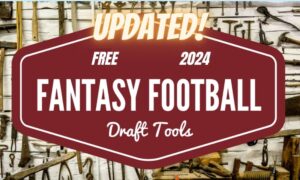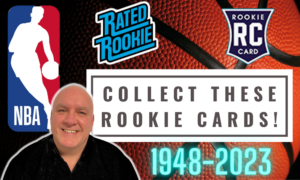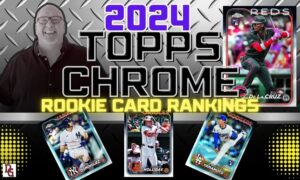Back in the early 2000s, I got hooked up with a couple Fantasy Football writers that wanted to start a new league with me. Josh Kerkau and Brian Roberson invited me to join their Absolute Gridiron Association, which 10 years later, I now deem “The Most Interesting Fantasy Football League Ever.”
To put it simpy, this was a dynasty, IDP, auction league. But, as you can imagine, it was much more involved than that. A few weeks ago, a friend told me they were changing from a straight yearly league, to a keeper league – with an auction draft. That reminded me of this league, and it made me realize just how special this league really was.
Over the past decade, I’ve worked with dozens of other writers, including my five years at CBSSports.com. Dave Richard and I would always discuss strategy about this league, as he helped me gauge the incoming rookies every season.
The league was incredibly intense, and owners bowed out every few years, including Kerkau, who was out after three or four seasons. I finally left the league in 2010 – after never coming very close to winning it.
Interesting Aspects of the Most Interesting Fantasy Football League
When you drafted a player (won him in the auction), you had to decide on how long of a contract you wanted to sign him to: one, two, three or four years long. Once the contract was over, you could “Franchise” tag him, or throw him back in the player pool. You were also able to trade him to another owner, who was then allowed to give him a contract extension.
The auction draft was a slow draft held on MyFantasyLeague.com – an awesome site for handling quirky leagues like this – and any other league, really. Basically, you’d nominate a couple players at a time, and the entire league was able to bid on the player. The player was won after nobody bids on the player for 24 hours. So a bidding war would ensue, then it would slow, and finally, after 24 hours of no one bidding, the player would be won.
We had a rookie draft every season. Seven rounds of rookies were selected every year, in a worst-to-first non-snake order. Each rookie slot was given a salary number, which counted toward your salary cap.
Our salary cap would gradually increase each season, just like the NFL’s salary cap.
When you cut a player, your cap penalty depended on how many years left that player had on his contract.
We made it so that the $100 yearly league fee increased to $125, with $25 going into a jackpot that rolled over each season until Year 4, when the winner of that season got a Super Duper Jackpot. This helped keep owners in the league from year to year, since they had already invested in future seasons.
The Most Interesting Fantasy Football League Rules
Below, I’ve copied over the entire rules for your reading pleasure. I’m sure there are many leagues out there that borderline the similar amounts of insanity that this one had. Shoot me an email through the Contact page and tell me about it!
Is your league the most interesting Fantasy Football league ever?
I. Divisions and Schedule
A. The AGA League will consist of three divisions of four teams. League primary website will be found at myfantasyleague.com. The 2010 URL is www8.myfantasyleague.com/2010/home/33721#0. All league reports can be found there. Teams will be placed in divisions according to their order of finish the prior season. 1st, 4th, 7th and 10th ranked teams are in the Gulf Coast Division. 2nd, 5th, 8th and 11th ranked teams are in the Great Plains Division. 3rd, 6th, 9th and 12th ranked teams are in the Rocky Mountain Division. The AGA schedule will be posted before rosters are completed.
B. The regular season will be 13 weeks. Each week, each team will play two other teams. During weeks 5 and 10, each team will play three other teams. The trading deadline will be kickoff of the first week 10 game.
C. Playoffs will begin week 14. The three division winners gain the top three seeds in the playoffs. The three wild card slots will be awarded to the three teams with the best records regardless of division. In the event of a tie of records, the NFL tie-breaker system will be used to determine playoff teams.
To Break a Tie Within a Division, Two Clubs
1. Head-to-head
2. Best won-lost percentage in games played within the division
3. Best won-lost percentage in common games
4. Most net points in division games
5. Most net points in all games
6. Coin toss
To Break a Tie Within a Division, Three or More Clubs
1. Head-to-head
2. Best won-lost percentage in games played within the division
3. Best won-lost percentage in common games
4. Most net points in division games
5. Most net points in all games
6. Coin toss
To Break a Tie For The Wild Card Team
1. If the tied clubs are from the same division, apply the division tiebreaker
2. If the tied clubs are from different divisions, apply the following steps:
To Break a Tie for Two Wild Card Teams from Different Divisions
1. Head-to-head
2. Best won-lost percentage in common games, minimum of four
3. Most net points in all games
4. Coin toss
To Break a Wild-Card Tie with Three or More Clubs
1. Apply division tiebreaker to eliminate all but the highest-ranked club in each division prior to proceeding to Step 2.
2. Head-to-head sweep, applicable only if one club has defeated each of the others or if one club has lost to each of the others.
3. Best won-loss percentage in common games, minimum of four
4. Most net points in all games
5. Coin toss
D. Playoff teams will be matched up like this:
WEEK 14
· #3 SEED (LOWEST DIVISION WINNER) HOSTS THE #6 SEED (LOWEST WILDCARD)
· #4 SEED (WILDCARD) HOSTS THE #5 SEED (WILDCARD)
· #1 and #2 SEEDS RECEIVE A BYE
WEEK 15
· #1 SEED HOSTS THE LOWEST REMAINING SEED
· #2 SEED HOSTS THE HIGHEST REMAINING SEED WINNER FROM WEEK 14
WEEK 16
THE ABSOLUTE GRIDIRON BOWL!!
1) Lineups must be submitted for every week of the playoffs. Carry-over lineups from the previous week(s) are not valid.
2) During the playoffs, teams will be allowed to submit a list of backups (one per position) that will be used if a starter does not play or is injured in the first half of his game and doesn’t return. Proof of this must be obtained from NFL.com via the play by play account of the game or be picked up by an agreed upon news source.
II. Rosters
A. Construction
- Active players and IR players count toward the salary cap.
- Practice Squad players do not count against the cap until activated.
- During the season rosters will consist of a maximum of 38 active players, minimum of 30 players and a maximum of 5 practice squad players and 3 IR spots.
- Required position numbers are at least 1 QB, 2 RB, 3 WR, 1TE, 1PK, 11 IDP’s.
- Roster totals may exceed these numbers in the offseason as a result of trades, pickups, or the rookie draft.
B. Injured Reserve
- Teams may reserve up to three players on the IR list. The player must be on the official NFL IR or PUP List.
- Players cannot be put onto the IR until after Week 1.
- A player on IR will have his salary reduced by one half for the remainder of the current season. If a player is CUT while on IR, the owner will take a one half salary cap hit on that player.
- A player on IR may be cut to make room for another player. Once cut, that player’s salary determines the cap penalties.
- Once a player is put on IR, he is ineligible for the rest of the season and/or playoffs for that team.
- If a player on IR is cut and then picked back up via free agency, the player is eligible to be placed on the active roster or PS of the new team.
C. Practice Squad
- Teams may reserve up to five players on their Practice Squad (PS).
- PS players do not count against the team salary cap until activated to the roster.
- Players may remain on a the PS for up to TWO seasons.
- PS players are PS-eligible only if they have played less than two seasons in the NFL.
- This does not equate to two seasons removed from his last college game. Once the two year period is started, it may not be interrupted due to injury. EXAMPLE: Robert Edwards was injured after his rookie season. He missed his second season while recovering from the injury. He was NOT eligible for the PS in his third season.
- AGA will officially move from the previous season to the next season 48 hours prior to the start of RFA/Tagged Player Auction. e.g. A second year player officially becomes a third year player on this date.
- Teams will be able to put PS eligible players on the PS no earlier than 48 hours prior to the start of RFA/Tagged Player Auction.
- During the season, other teams may request to sign another teams PS player to their active roster.
- PS claims are sent to the commissioner by 9 PM each Tuesday following week 1.
- At that time, each team will be notified of PS claims made on their players and have until 12:00 noon Thursday to decide whether to activate the claimed player to their active roster or let the player go.
- PS claims are not first come/first served (FCFS); if two teams make a claim on the same player the lower ranked team (as determined by the AGA tie-breaker system) gets the claim.
- Players on your active roster that qualify for the PS may be placed on the PS at anytime during the season, but once re-activated are no longer PS eligible for that season.
- A PS-eligible player may be placed back on the PS in his 2nd season.
- A player may only be activated from a team’s PS once per season.
- If the player is traded, the player must be placed on the new owner’s PS.
- A PS player can be released from the PS without taking a cap penalty.
- This holds true in year two of PS status regardless if the player was activated in year one.
- PS-Eligible players may be released at any time during the season or offseason with no penalty.
III. Starting Lineups
- 1 Quarterback
- 2 Running Backs
- 2 Wide Receivers
- 1 Tight End
- 2 Flex Offensive Players (RB, WR or TE)
- 1 Kicker
- 3 Defensive Linemen
- 2 Linebackers
- 4 Defensive Backs
- 2 Flex Defensive Players (DL, LB or DB)
STARTING LINEUPS will consist of 20 total players.
- During the regular season, if a lineup is not submitted on time, the team will play with the prior week’s lineup. The commissioner will NOT make any changes to lineups voluntarily with regards to bye weeks, injuries, or incomplete lineups.
- In the event of a THURSDAY game, partial lineups may be submitted containing only those players playing in the THURSDAY game. All THURSDAY players MUST be started before the Thursday game. The same goes for Saturday games.
- Lineups must be submitted for all playoff games; the prior weeks lineup will NOT be automatically used.
IV. Scoring and Statistics
OFFENSIVE SCORING and BONUSES:
- 6 Points for any TD
- 1 Point per 20 Yds Passing (.05 per passing yard)
- 1 Point per 10 Yds Rushing or Receiving (.1 per yard rushing or receiving)
- 1 Point per Reception
- 2 Points per 2 Pt Conversion
- 1 Point per 2 Pt Conversion Pass
- 1 Point per PAT Kicked
- 3 Points per FG Made up to 39 Yds
- 4 Points per FG Made 40-49 Yds
- 5 Points per FG Made 50-59 Yds
- 6 Points per FG Made 60+ Yds
- -2 Points for any FG missed less than 40 Yds
- -1 Point PAT Missed (not blocked)
- -2 Points for an Interception
- -1 Point for any Fumble lost by an Offesive Player
- 4 Points per each 100 Yds Rushing
- 4 Points per each 150 Yds Receiving
- 4 Points per 300 Yds Passing
- 3 Points per 10 Receptions
DEFENSIVE SCORING and BONUSES:
- 6 Points per any TD Scored
- 2 Points per Solo Tackle
- 1 Point per Assist Tackle
- 5 Points per Interception
- 5 Points per Forced Fumble
- 2 Points per Fumble Recovery
- 1 Point per Pass Defensed
- 4 Points per Sack
- 2 Points per 1/2 Sack
- 8 Points per Credited Safety
- 4 Points per 1/2 Safety if two players are credited
- 4 Points for a 3 Sack Game
- 4 Points for a 2 Interception Game
- 4 Points for a 12 Solo Tackle Game
* Offensive players can only score offensive/special teams points.
* Defensive players can score defensive/special teams points and offensive points.
V. Transactions
A. Free Agents
- Free Agent requests must be made by 8:00 pm EST each Thursday, starting with the Thursday following games in Week One.
- Owners may request up to 2 Free Agents per Thursday deadline.
- When putting in a request for a Free Agent, the owner should submit a maximum bid for that player; the minimum bid for a Free Agent is $300,000.
- The team that submitted the highest bid wins the player.
- The new salary of the player will be $50,000 higher than the second highest bid.
- If two or more teams have the same high bid for a player, the team with the worse record will receive the player; if still tied then the team with the lower total points is awarded the player.
- After the Thursday transactions are processed, teams may make an unlimited number of FA requests on a first come, first serve basis.
- Newly acquired players are eligible to be traded immediately.
- The necessary cap room will be needed to sign a Free Agent.
- When making multiple Free Agent requests, place them in order of preference.
- Free Agents who have played less than 2 years in the NFL are eligible for the Practice Squad, in which case they will not count toward the salary cap if placed on the PS.
- The Free Agent pickup deadline is the end of the AGA regular season.
- The default contract length for a Free Agent is one year, unless designated differently at the time of signing.
- No player dropped after week 12 may be acquired as a free agent during the playoffs.
- Any player picked up as a free agent during the playoffs must be dropped at the end of the playoffs.
B. Waivers
- A dropped player is not eligible to be claimed by another team until the next weekly transaction period.
C. Trades
- The Trade Deadline is kickoff of the first game of Week 10 .
- Owners are allowed unlimited trading.
- Owners need to have enough cap space to complete a trade, before an extension is completed.
- Trade concerns will be heard by the Commissioner, and if necessary put to a vote. A ¾ majority vote would be needed to overturn a trade. This would only happen in the event that dumping or collusion was suspected.
- Trading of AGA Rookie Draft picks is allowed. Draft picks do not count against the cap until the player is selected with that pick. Draft picks can be traded up to TWO years in advance.
NOTE: In order to sign Restricted Free Agents and/or Tagged players in the offseason, the signing team must have the appropriate draft picks as specified in the rules.
D. Contract Extensions
- When a trade is completed, owners have the opportunity to extend the new players contract.
- Players that are in the second or later year of a multi-year contract or are currently signed to a one year deal are eligible for extensions.
- The player’s current salary can be lowered a certain percentage for each year added to the contract. Maximum contract length is four years.
- Only players acquired via trades or successful Practice Squad claims are eligible for contract extensions.
- Once a player’s contract is extended, he is no longer eligible for restricted free agency.
- All future owners lose the right to match a contract offer on that player at the end of his extended contract.
- An extended player is ineligible to be Franchise or Transition tagged.
- After an extension is made, the current year acts as year one of the new contract and the contract will follow the percentage increases described in the next section.
- Contract escalators are as follows.
YEARS ADDED
PERCENTAGE CONTRACT LOWERED
One Year
10%
Two Years
15%
Three Years
25%
VI. Franchise Setup
A. Please be creative when putting together the cosmetic side of your franchise such as identifying team colors, helmets and locational information in the extra comments section of the ADVANCED FRANCHISE SETUP window on the website. Please visithttp://www.inside99.net/Helmet_Project/ to find a helmet that fits your franchise best. Creativity is encouraged!
B. It is suggested that each owner name his team in the conventional CITY/STATE/REGION – Mascot format. Example: Florida Tarpons, Carson City Gun Runners, Bangor Behemoths…etc. The city/state should be an actual location in North America. (That would be Canada, USA, or Mexico for those short in the geography department!) We are just trying to be uniform and also trying to convey the image of quality ownership. Sexually suggestive or culturally insensitive team names may be replaced if complaints are voiced.
VII. League Funds
YEARLY COMPENSATION BREAKDOWN:
TOTAL LEAGUE FEES: $1100
- WINNER OF THE THE ABSOLUTE GRIDIRON BOWL – $600
- LOSER OF THE ABSOLUTE GRIDIRON BOWL – $200
- Weekly Highest Scoring Team (weeks 1-13) – $10
- Division Winners (3) – $20
- Wildcard Teams (3) – $10
- Highest Overall Scoring Team, Season – $50
- Offensive MVP (Decided by league vote) – $10
- Defensive MVP (Decided by league vote) – $10
- General Manager of the Year (Decided by league vote) – $10
2011 PROGRESSIVE COMPENSATION BREAKDOWN:
TOTAL LEAGUE FEES: $2000
- WINNER OF THE THE ABSOLUTE GRIDIRON BOWL – $1000
- LOSER OF THE ABSOLUTE GRIDIRON BOWL – $400
- Weekly Highest Scoring Team (weeks 1-13) – $20
- Division Winners (3) – $30
- Wildcard Teams (3) – $15
- Highest Overall Scoring Team, Season – $105
- Offensive MVP (Decided by league vote) – $25
- Defensive MVP (Decided by league vote) – $25
- General Manager of the Year (Decided by league vote) – $50
MVP/GM of the Year voting
At the conclusion of the AGA season, all owners are obliged to participate in three votes. The owners will vote for an Offensive League MVP, a Defensive League MVP and the General Manager of the Year. The vote will be conducted via email. Each owner will vote for a 1st, 2nd, and 3rd place in each category. The votes will be tallied with 1st place votes = 3 points, 2nd place = 2 points, and 3rd place = 1 point. Highest point total wins the award. Owners may not vote for their own players or themselves (GM). Notification for voting will be sent out the week before the ABSOLUTE GRIDIRON BOWL and will be due a week after the championship game. Failure to vote will result in LOSS of a 2ND round pick in the upcoming Rookie Draft. If offending owner has multiple 2nd round picks, the highest one will be forfeited. If offending owner does not have a 2nd round pick in the upcoming draft, a fine of $1 million salary cap will be levied for the following season.
League payouts will occur within 30 days of the MVP voting results.
VIII. Rookie Draft
The AGA Rookie draft will be held at the completion of the Free Agent auction each season. The draft order is NFL style (not serpentine) based on reverse of records. Trading of draft picks is allowed before and during the draft. An owner is not allowed to exceed the salary cap at any point. Future draft picks can be traded, but no more than two years in advance. The draft will last 6 rounds. Owners may draft rookies and move them directly to their Practice Squad and not incur any cap costs during the rookie draft if they have vacant PS slots to do so.
Rookie salaries will be determined by the following chart:
Rookie Salary Chart
Round
One
Round
Two
Round
Three
Round
Four
Round
Five
Round
Six
#1
2.00M
#13
1.40M
#25
1.00M
#37
500k
#49
200k
#61
100k
#2
1.95M
#14
1.35M
#26
950k
#38
450k
#50
200k
#62
100k
#3
1.95M
#15
1.35M
#27
925k
#39
425k
#51
200k
#63
100k
#4
1.90M
#16
1.30M
#28
900k
#40
400k
#52
200k
#64
100k
#5
1.85M
#17
1.30M
#29
850k
#41
375k
#53
175k
#65
100k
#6
1.85M
#18
1.25M
#30
825k
#42
350k
#54
175k
#66
100k
#7
1.80M
#19
1.25M
#31
800k
#43
325k
#55
150k
#67
100k
#8
1.75M
#20
1.20M
#32
750k
#44
300k
#56
150k
#68
100k
#9
1.70M
#21
1.20M
#33
700k
#45
300k
#57
150k
#69
100k
#10
1.65M
#22
1.15M
#34
650k
#46
250k
#58
150k
#70
100k
#11
1.60M
#23
1.10M
#35
625k
#47
250k
#59
125k
#71
100k
#12
1.60M
#24
1.05M
#36
600k
#48
225k
#60
125k
#72
100k
IX. Contract Options
A. Contract Types
After the initial player auction, all owners will need to designate contract length for each player. Deadline is one week from the end of the rookie draft. If contract lengths are not designated, default contract length will be one year. There are benefits and drawbacks that owners will need to weigh when assigning contract lengths. Here are the four types of contracts and the pay increases involved. Increases are based on original bid price.
4 YEAR CONTRACT
3 YEAR CONTRACT
2 YEAR CONTRACT
1 YEAR CONTRACT
Year 1
Original Bid
Original Bid
Original Bid
Original Bid
Year 2
Original Bid
15% increase
20% increase
N/A
Year 3
25% increase
30% increase
N/A
N/A
Year 4
50% increase
N/A
N/A
N/A
A. Restricted Free Agents (RFA)
- After a player’s original AGA contract expires, the player becomes a RFA.
- The current owner has the option to put in a qualifying bid in order to obtain compensation in the event another team wishes to sign the RFA.
- If the owner does not put in a qualifying bid, the player becomes an Unrestricted Free Agent (UFA).
- After the deadline for qualifying bids, other teams have the opportunity to bid for the player.
- Once the RFA bidding period is over, the current owner has the option to match the highest bid or take the compensation attached to that player.
- Qualifying offers determine the amount of compensation.
- A 10% increase from the last year of the player’s original contract would draw compensation of one 2nd round draft pick.
- A 20% increase from the last year of the player’s original contract would draw compensation of one 1st round draft pick.
- A 30% increase from the last year of the player’s original contract would draw compensation of a 1st and 3rd round draft pick.
B. Franchise Tags
- Each team is allowed to tag one player as their Franchise Player.
- The Franchise Player tag is only applicable to players who are at the end of their contract.
- Each team announces their Franchise Player on a date specified on the league calendar along with a qualifying offer.
- A qualifying offer for a Franchise player must be $50,000 higher than the player’s previous seasons salary OR equal to the average of the TOP FIVE current salaries in the league at that position the previous season, whichever is greater.
- Franchise players are eligible for bidding only during the Restricted Free Agency period as noted on the league calendar.
- Teams may go over the salary cap when bidding on Franchise players.
- Only teams with the required draft choice compensation are eligible for bidding on Franchise players.
- Once the top bids for each of the tagged players have been announced, other team owners will have the opportunity to match the highest bid or accept draft choice compensation from the team with the highest bid.
- Compensation for a Franchise Player is TWO 1st Round draft choices and $2 million from the winning team’s salary cap total.
- If a team bidding on a Franchise player has two first round draft choices in the immediate College Draft, the team receiving the compensation may choose whether to accept both picks immediately or defer one to the next season.
- Franchise players may be traded at any time during designated AGA trading periods except during the Free Agency period for RFA, Transition and Franchise players.
- If a Franchise player is traded, the Franchise player tag does NOT follow the player to the new team.
- Franchise player tags remain with a player until the end of the current season or until the player is waived or traded.
C. Transition Tags
- Each team is allowed to tag two offensive players and two defensive players as their Transition Players.
- The Transition Player tag is only applicable to players who are at the end of their contract.
- Each team announces their Transition Player on a date specified on the league calendar along with a qualifying offer.
- A qualifying offer for a Transition player must be $50,000 higher than the player’s previous seasons salary OR equal to the average of the TOP TEN current salaries in the league at that position the previous season, whichever is greater.
- Transition players are eligible for bidding only during the Restricted Free Agency period as noted on the league calendar.
- Teams may go over the salary cap when bidding on Transition players.
- Only teams with the required draft choice compensation are eligible for bidding on Transition players.
- Once the top bids for each of the tagged players have been announced, other team owners will have the opportunity to match the highest bid or accept draft choice compensation from the team with the highest bid.
- Compensation for a Transition Player is a 2nd Round draft choice and $1 million from the winning team’s salary cap total.
- Transition players may be traded at any time during designated AGA trading periods except during the Free Agency period for RFA, Transition and Franchise players.
- If a Transition player is traded, the Transition player tag does NOT follow the player to the new team.
- Transition player tags remain with a player until the end of the current season or until the player is waived or traded.
X. Free Agent Auction
- All veteran Unrestricted Free Agents (players not on a roster) will be eligible for the Free Agent Auction.
- This auction will be conducted at the AGA website in a similar manner to the player allotment auction.
- The Free Agent Auction will precede the AGA Rookie Draft.
- Owners must be under the cap at all times during the FA Auction/Rookie Draft.
XI. Cap Penalties
- At no time are teams allowed to exceed the salary cap during the season.
- Once the season ends, players on IR and PS squads are placed back on the active roster.
- During this time, teams are allowed to exceed the salary cap.
- Teams are allowed to exceed the salary cap when bidding on RFAs and tagged players.
- Teams must be under the salary cap at the conclusion of the RFA/Tagged Player Auction.
- During the regular season, teams may not make roster changes that would put them over the cap limit.
- If a team has not made the appropriate roster moves to get below the cap limit by lineup deadlines, the team forfeits all games that week.
- All teams are responsible for staying within their cap
- Cutting players before their contracts expire will result in cap penalties.
- When a player is cut, the team is still responsible for a percent of what his future salary was going to be.
- The following chart will be used to determine what percent (cap penalty) of the players salary the team will still be responsible for after cutting the player:
4 Yr
3 Yr
2 Yr
1 Yr
1yr left
25%
25%
25%
50%
2 yr left
40%
50%
50%
N/A
3 yr left
50%
75%
N/A
N/A
4 yr left
75%
N/A
N/A
N/A
Teams that exceed their cap with a winning bid or finish the draft without meeting their roster minimums will have that winning bid voided and will be penalized as follows:
- For exceeding the salary cap:
- First Offense: Loss of one Franchise Tag and $1 million in cap money.
- Second Offense: Loss of a second Franchise Tag and $1 million in additional cap money.
- Third Offense: Loss of two Transitional Free Agent Tags and $2 million in additional cap money.
- Fourth Offense: Loss of two Transitional Free Agent Tags and $2 million in additional cap money.
- Fifth (or more) Offense: Loss of $1 million in cap money for each consecutive offense.
- For not meeting mandatory roster requirements:
- Loss of 2nd round pick in rookie draft and loss of 1 million salary cap dollars.
XII. Expansion Contingency
In the event that an owner departs or is removed from the league, an “expansion team” format will be put in place the following off-season. The specifics of this format will be voted on by the league on an individual team basis, but can include the following:
- Each team will make available 3 players for an expansion draft.
- Each team may lose no more than two players.
- If a player is selected from their list of three players, that team has the option to pull back one of the two remaining players.
- The expansion owner will be given additional rookie draft picks in the first rookie draft that occurs after taking over the team.
- Those picks will come at the end of rounds 2, 4, and 6.
- The additional picks cannot be traded, but the players selected can be traded after the draft.
- The new owner would be able to cut players with a 50% decrease in cap penalties for the first off-season after assuming the franchise.
XIII. Amendments/Rule Changes
Each off-season the owners will have the opportunity to submit rule changes to be voted upon by the league. Rule changes will need a majority vote (7 owners).
XIV. Owner Expectations
In this league owners will be expected to adhere to the following principles.
· NEVER GIVE UP TRYING TO WIN YOUR NEXT GAME
· DO NOT BICKER WITH OTHER OWNERS
· DO NOT ASK FOR “SPECIAL” FAVORS FROM THE COMMISH
· DOUBLE CHECK YOUR SCORE EACH AND EVERY WEEK
· PAY YOUR LEAGUE FEES ON TIME
· ADD YOUR OWN FLAVOR TO MAKE THIS A DYNAMIC, FUN LEAGUE
· DO NOT ENGAGE IN ANY FORM OF COLLUSION OR DUMPING…
– Owners may be relieved of their franchise by a vote of at least 8 other owners if it is deemed to be in the best interest of the league.
– It would take three incidences of “misconduct” for removal to be put to a vote. 1st time = warning, 2nd time = probation, 3rd time = vote for dismissal.
– Probation shall be a 2nd round draft pick and loss of $1 million cap dollars

1. Head-to-head
2. Best won-lost percentage in games played within the division
3. Best won-lost percentage in common games
4. Most net points in division games
5. Most net points in all games
6. Coin toss
To Break a Tie Within a Division, Three or More Clubs
1. Head-to-head
2. Best won-lost percentage in games played within the division
3. Best won-lost percentage in common games
4. Most net points in division games
5. Most net points in all games
6. Coin toss
1. If the tied clubs are from the same division, apply the division tiebreaker
2. If the tied clubs are from different divisions, apply the following steps:
1. Head-to-head
2. Best won-lost percentage in common games, minimum of four
3. Most net points in all games
4. Coin toss
1. Apply division tiebreaker to eliminate all but the highest-ranked club in each division prior to proceeding to Step 2.
2. Head-to-head sweep, applicable only if one club has defeated each of the others or if one club has lost to each of the others.
3. Best won-loss percentage in common games, minimum of four
4. Most net points in all games
5. Coin toss
· #3 SEED (LOWEST DIVISION WINNER) HOSTS THE #6 SEED (LOWEST WILDCARD)
· #4 SEED (WILDCARD) HOSTS THE #5 SEED (WILDCARD)
· #1 and #2 SEEDS RECEIVE A BYE
WEEK 15
· #1 SEED HOSTS THE LOWEST REMAINING SEED
· #2 SEED HOSTS THE HIGHEST REMAINING SEED WINNER FROM WEEK 14
THE ABSOLUTE GRIDIRON BOWL!!
- This does not equate to two seasons removed from his last college game. Once the two year period is started, it may not be interrupted due to injury. EXAMPLE: Robert Edwards was injured after his rookie season. He missed his second season while recovering from the injury. He was NOT eligible for the PS in his third season.
- PS claims are sent to the commissioner by 9 PM each Tuesday following week 1.
- At that time, each team will be notified of PS claims made on their players and have until 12:00 noon Thursday to decide whether to activate the claimed player to their active roster or let the player go.
- PS claims are not first come/first served (FCFS); if two teams make a claim on the same player the lower ranked team (as determined by the AGA tie-breaker system) gets the claim.
- This holds true in year two of PS status regardless if the player was activated in year one.
- PS-Eligible players may be released at any time during the season or offseason with no penalty.
- When putting in a request for a Free Agent, the owner should submit a maximum bid for that player; the minimum bid for a Free Agent is $300,000.
- The team that submitted the highest bid wins the player.
- The new salary of the player will be $50,000 higher than the second highest bid.
- If two or more teams have the same high bid for a player, the team with the worse record will receive the player; if still tied then the team with the lower total points is awarded the player.
One Year
10%
Two Years
15%
Three Years
25%
At the conclusion of the AGA season, all owners are obliged to participate in three votes. The owners will vote for an Offensive League MVP, a Defensive League MVP and the General Manager of the Year. The vote will be conducted via email. Each owner will vote for a 1st, 2nd, and 3rd place in each category. The votes will be tallied with 1st place votes = 3 points, 2nd place = 2 points, and 3rd place = 1 point. Highest point total wins the award. Owners may not vote for their own players or themselves (GM). Notification for voting will be sent out the week before the ABSOLUTE GRIDIRON BOWL and will be due a week after the championship game. Failure to vote will result in LOSS of a 2ND round pick in the upcoming Rookie Draft. If offending owner has multiple 2nd round picks, the highest one will be forfeited. If offending owner does not have a 2nd round pick in the upcoming draft, a fine of $1 million salary cap will be levied for the following season.
Round
One
Round
Two
Round
Three
Round
Four
Round
Five
Round
Six
#1
2.00M
#13
1.40M
#25
1.00M
#37
500k
#49
200k
#61
100k
#2
1.95M
#14
1.35M
#26
950k
#38
450k
#50
200k
#62
100k
#3
1.95M
#15
1.35M
#27
925k
#39
425k
#51
200k
#63
100k
#4
1.90M
#16
1.30M
#28
900k
#40
400k
#52
200k
#64
100k
#5
1.85M
#17
1.30M
#29
850k
#41
375k
#53
175k
#65
100k
#6
1.85M
#18
1.25M
#30
825k
#42
350k
#54
175k
#66
100k
#7
1.80M
#19
1.25M
#31
800k
#43
325k
#55
150k
#67
100k
#8
1.75M
#20
1.20M
#32
750k
#44
300k
#56
150k
#68
100k
#9
1.70M
#21
1.20M
#33
700k
#45
300k
#57
150k
#69
100k
#10
1.65M
#22
1.15M
#34
650k
#46
250k
#58
150k
#70
100k
#11
1.60M
#23
1.10M
#35
625k
#47
250k
#59
125k
#71
100k
#12
1.60M
#24
1.05M
#36
600k
#48
225k
#60
125k
#72
100k
4 YEAR CONTRACT
3 YEAR CONTRACT
2 YEAR CONTRACT
1 YEAR CONTRACT
Original Bid
Original Bid
Original Bid
Original Bid
Original Bid
15% increase
20% increase
N/A
25% increase
30% increase
N/A
N/A
50% increase
N/A
N/A
N/A
A. Restricted Free Agents (RFA)
- A 10% increase from the last year of the player’s original contract would draw compensation of one 2nd round draft pick.
- A 20% increase from the last year of the player’s original contract would draw compensation of one 1st round draft pick.
- A 30% increase from the last year of the player’s original contract would draw compensation of a 1st and 3rd round draft pick.
- If a team bidding on a Franchise player has two first round draft choices in the immediate College Draft, the team receiving the compensation may choose whether to accept both picks immediately or defer one to the next season.
- During this time, teams are allowed to exceed the salary cap.
4 Yr
3 Yr
2 Yr
1 Yr
1yr left
25%
25%
25%
50%
2 yr left
40%
50%
50%
N/A
3 yr left
50%
75%
N/A
N/A
4 yr left
75%
N/A
N/A
N/A
Teams that exceed their cap with a winning bid or finish the draft without meeting their roster minimums will have that winning bid voided and will be penalized as follows:
- First Offense: Loss of one Franchise Tag and $1 million in cap money.
- Second Offense: Loss of a second Franchise Tag and $1 million in additional cap money.
- Third Offense: Loss of two Transitional Free Agent Tags and $2 million in additional cap money.
- Fourth Offense: Loss of two Transitional Free Agent Tags and $2 million in additional cap money.
- Fifth (or more) Offense: Loss of $1 million in cap money for each consecutive offense.
- Loss of 2nd round pick in rookie draft and loss of 1 million salary cap dollars.
- Each team may lose no more than two players.
- If a player is selected from their list of three players, that team has the option to pull back one of the two remaining players.
- Those picks will come at the end of rounds 2, 4, and 6.
- The additional picks cannot be traded, but the players selected can be traded after the draft.
· NEVER GIVE UP TRYING TO WIN YOUR NEXT GAME
· DO NOT BICKER WITH OTHER OWNERS
· DO NOT ASK FOR “SPECIAL” FAVORS FROM THE COMMISH
· DOUBLE CHECK YOUR SCORE EACH AND EVERY WEEK
· PAY YOUR LEAGUE FEES ON TIME
· ADD YOUR OWN FLAVOR TO MAKE THIS A DYNAMIC, FUN LEAGUE
· DO NOT ENGAGE IN ANY FORM OF COLLUSION OR DUMPING…
– Owners may be relieved of their franchise by a vote of at least 8 other owners if it is deemed to be in the best interest of the league.
– It would take three incidences of “misconduct” for removal to be put to a vote. 1st time = warning, 2nd time = probation, 3rd time = vote for dismissal.
– Probation shall be a 2nd round draft pick and loss of $1 million cap dollars






























